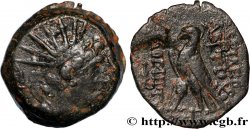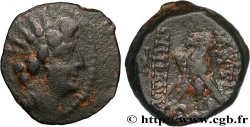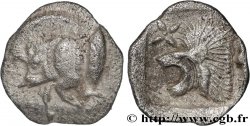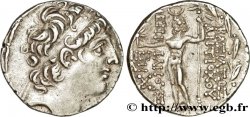v53_0113 - SIRIA - REGNO DI SIRIA - ANTIOCO VIII GRYPOS Tétradrachme
MONNAIES 53 (2012)
Начальная цена : 450.00 €
Назначить цену : 750.00 €
Цена реализации : 450.00 €
Количество ставок : 1
Максимальная предлагаемая цена : 550.00 €
Начальная цена : 450.00 €
Назначить цену : 750.00 €
Цена реализации : 450.00 €
Количество ставок : 1
Максимальная предлагаемая цена : 550.00 €
Тип Tétradrachme
Дата: an 193
Монетный двор / Город: Phénicie, Sidon
Металл: silver
Диаметр: 27,5 mm
Ориентация осей монеты: 12 h.
Вес: 16,46 g.
Редкость: R2
Комментарии о состоянии
Exemplaire sur un petit flan ovale, bien centré des deux côtés. Beau portrait d’Antiochus VIII de haut relief, bien venu à la frappe. Joli revers de style fin, particulier avec un très beau portrait de Zeus. Très belle patine de collection ancienne gris foncé avec des reflets dorés. Conserve une partie de son coupant d’origine
Ссылки в каталоге: :
Происхождение:
Cet exemplaire provient de la collection Claude Lainé (emblème luni-solaire)
Лицевая сторона
Аверс: легенда: ANÉPIGRAPHE.
Аверс: описание: Tête diadémée d’Antiochus VIII à droite, entourée de la stemma.
Обратная сторона
Реверс: Описание: Zeus Uranios nu, debout à gauche, la tête surmontée d'un croissant, à demi-nu, la chlamyde sur l'épaule, tenant une étoile à huit rais (emblème luni-solaire) de la main droite et de la gauche un sceptre long.
Реверс: легенда: BASILEWS// ANTIOCOU// EPI-FANOUS/ SI IER/ /AS/ (AU)/ [GRR]
Реверс: перевод: (du roi Antiochus glorieux).
Комментарий
Sur cet exemplaire, Antiochus n’a pas l’appendice nasal proéminent qui le caractérise (grypus). La stemma, bandelette de laine qui entoure le portrait est peu visible. Le revers présente un symbole luni-solaire. Il y avait un exemplaire dans le trésor de Kessab (IGCH. 1568) découvert en 1952, enfoui vers 110 avant J.-C. qui contenait plus de 388 monnaies d’argent dont 102 tétradrachmes d’Antiochus VIII dont cinq pour l’atelier de Sidon et trois exemplaires avec notre variété.
On this example, Antiochus does not have the prominent nasal appendage that characterizes him (grypus). The stemma, a woolen band that surrounds the portrait, is barely visible. The reverse has a lunisolar symbol. There was a example in the Kessab treasure (IGCH. 1568) discovered in 1952, buried around 110 BC, which contained more than 388 silver coins including 102 tetradrachms of Antiochus VIII, five of which were for the Sidonian mint, and three examples with our variety
On this example, Antiochus does not have the prominent nasal appendage that characterizes him (grypus). The stemma, a woolen band that surrounds the portrait, is barely visible. The reverse has a lunisolar symbol. There was a example in the Kessab treasure (IGCH. 1568) discovered in 1952, buried around 110 BC, which contained more than 388 silver coins including 102 tetradrachms of Antiochus VIII, five of which were for the Sidonian mint, and three examples with our variety








 Cообщить об ошибке
Cообщить об ошибке Распечатать страницу
Распечатать страницу Отправить мой выбор
Отправить мой выбор Задать вопрос
Задать вопрос Consign / sell
Consign / sell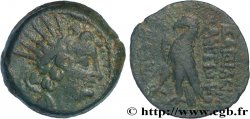
 Информация
Информация
